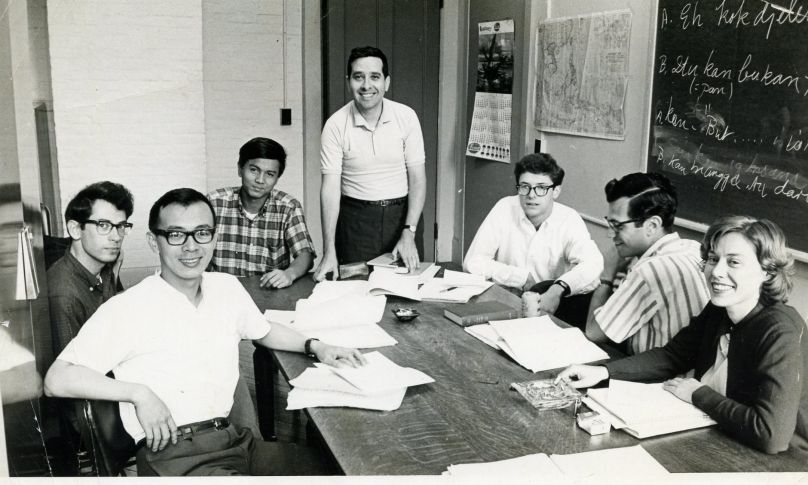Study of Southeast Asian Languages at Cornell: A History

by John Wolff, professor emeritus, linguistics and Asian studies
As featured in the Spring 2021 SEAP Bulletin, John Wolff, professor emeritus of linguistics and Asian studies, writes a history on the study of Southeast Asian Languages at Cornell. He recounts how and why learning the languages of Southeast Asia rose to significance in American history and within the history of academic development at Cornell.
Before World War II, Southeast Asia was of peripheral interest to American scholars. Even the Philippines, at the time a commonwealth under United States dominion, aroused meager scholarly interest. Aside from a few popular books and magazine articles that described exotic places and strange peoples, the Southeast Asian nations and their peoples were hardly written about or brought to the attention of the American public.
The war and the Japanese occupation of much of this area changed all that. The war effort brought into focus the importance to a successful defeat of our enemy that an understanding of these lands and their peoples had. This realization led the government to support the development of expertise in Southeast Asian matters, and that was the beginning of Southeast Asian area studies in the United States.
However, basic to the development of expertise in Southeast Asia was the knowledge of languages. It is impossible to learn what makes a culture tick and how a people think, if you cannot talk to them in ways that are familiar to them and inspire trust. To develop military personnel who could deal with the local populations in Southeast Asia as we pushed the Japanese back, we needed to help them develop language competence.
To meet the need for military personnel that knew languages of the countries Americans would occupy, the United States Army turned to the scholarly community to provide the pedagogical materials and instruction. The secretary of the American Council of Learned Societies (ACLS), F. Mortimer Graves, administered the project and chose Leonard Bloomfield, the foremost linguist of the day, to give the intellectual guidance for developing materials aimed at inculcating the languages of places where Americans were likely to go, including the countries of Southeast Asia.
The problem was that there was no tradition in America for teaching basic language competence in an effective way—not even in the widely studied European languages, much less in the languages of countries that were not within our ken. Bloomfield understood that the almost universal practice of the time, teaching language focusing on grammar and translation, hardly developed language competence and most certainly was wholly inappropriate for the learning of languages at that time considered exotic like Chinese and Japanese. It was no less appropriate for the languages of Southeast Asia. Under Bloomfield's direction, materials were prepared that were a sharp departure from the literature-oriented language pedagogy that was the norm throughout the United States
Bloomfield's methods involved linguists who directed native speakers. The native speaker's job was to drill dialogues that the students were supposed to memorize and to focus on conversing with the students, using the words and phrases that they had learned in the memorized dialogues. The focus was on oral use—reading and writing were secondary, in most cases totally left out. Materials were prepared for Burmese, Thai, Vietnamese (called "Annamite" in those days) and Malay, among the languages of Southeast Asia.
As American scholarship became more sophisticated and Southeast Asia became the focus of a number of scholars in a wide range of fields, the basic need for language competence became far better understood. In 1950 when Lauriston Sharp, an anthropologist with research in Thailand, applied for funds for the establishment of a program of Southeast Asian studies at Cornell University, a strong part of the proposal was that Cornell at the time had the reputation of being the center of the most advanced and successful language teaching in America.
Here is what happened to give Cornell University this reputation. In 1944-45, a language training program for Italian and Russian, using Bloomfield's methods, was set up by the army at Cornell for the training of army personnel. This program impressed the Dean of Arts and Sciences, at the time, C. W. De Kewiet, positively and after the war inspired him to propose establishing this method for teaching languages at Cornell. For this purpose he hired a member of the ACLS team, J. Milton Cowan, and De Kewiet's proposal was accepted.
Cowan brought to Cornell University linguists specializing in French and Italian, German, Spanish, Chinese, and Russian and later a number of others, who oversaw programs in these languages and also other languages, which they may not have known, but for which they found native speakers whom they could train in the Bloomfield method and direct. By 1949, Cornell’s Division of Modern Languages could boast of offering instruction (using the “Cornell Method”) in nine modern languages, including Arabic and English as a foreign language. Thai (Siamese) was added in 1951 with the advent of a Southeast Asia Program. When the Rockefeller Foundation made a grant to form a program of Southeast Asian Studies at Cornell, language instruction was a key part of the curriculum that was envisioned.[i] READ MORE
[i] The 1951 “Progress Report to the Rockefeller Foundation” states: “It is recognized that the program staff must include a mature scholar capable of taking charge of its work in linguistics and literature and of developing solutions to the problems involved in offering sound language training in an area with half a dozen major national languages"(p. 5).
